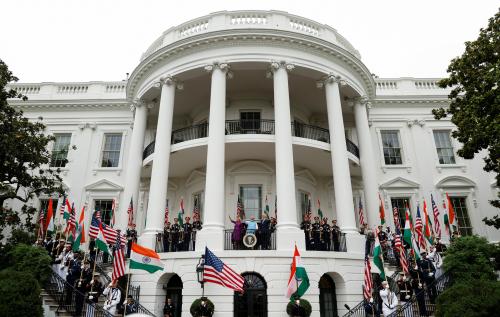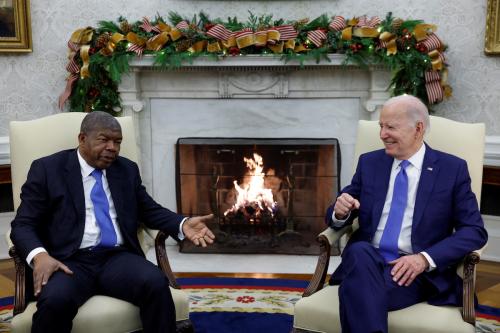This is text from a presentation prepared for The Aspen Institute Congressional Program on “U.S.-Russia Relations,” Berlin, August 15-21, 1999.
| “We are stuck halfway between a planned, command economy and a normal, market one. And now we have an ugly model—a cross-breed of the two systems.” —Boris Yeltsin, State of the Union address, February 1999 |
It has been one year since Russia’s financial collapse of August 1998. Those dramatic events forced a substantial shift in thinking inside and outside Russia about the near-term prospects of the Russian economy. Exaggerated optimism gave way to deep pessimism and cynicism. Unfortunately, we are still far from adequately acknowledging the extent of the problem. What sort of an economy is it? Is it a barely reformed planned economy, a half-reformed economy, a deeply flawed market economy, or is it something different from either its starting point—the planned economy—or its desired end point—a developed market economy?
The confusion is exemplified by the mixture of metaphors in the quote from Boris Yeltsin at the right. These metaphors are not only mixed: they are incompatible. A hybrid is not an evolutionary halfway point. It represents a distinct entity, which may or may not be capable of self-perpetuation. The biological metaphor is a good one for Russia’s economic development. Russia is not “halfway” to the market. It is not even on that track. Russia’s economy has mutated. It is a hybrid, a distinct economic system, neither a nonmonetized command economy nor a monetized market economy. It is something qualitatively new, with its own rules of behavior. In the following I will address the nature of this system, and use it to draw up some scenarios for the future. Unfortunately, one scenario that I consider so unlikely as to be unworthy of consideration is that Russia will have a “normal” market economy, one characterized by marketization, monetization, and modernization.
The Virtual Economy
The thesis I will outline is what Professor Barry Ickes of Pennsylvania State University and I have called “Russia’s virtual economy.” Our arguments begin with recognition of the huge burden of Russia’s Soviet past. Owing to the structural legacies of the previous system, the majority of Russia’s enterprises, especially those in the core manufacturing sectors, cannot survive in an even partially competitive market, and certainly not in one that is open to significant import competition. The market value of the things the Russian enterprises produce is smaller than the value of what is needed to produce them. And yet the collapse of these industries is socially and politically unacceptable, even when it might be economically rational to close and replace them. The result of these enterprises’ struggle to survive—and of a social consensus that they should survive—is a peculiar, new, and possibly unique, economic system that has evolved in Russia.
In this system, the enterprises can continue to produce their fundamentally noncompetitive goods—which are generally the same products they produced under the Soviet system, produced in the same way—because they avoid the use of money. Avoiding money, through the mechanisms of barter and other forms of nonmonetary exchange, allows the goods to be arbitrarily priced. They are overpriced, giving the appearance of more value being produced than is actually the case. Overpricing of manufactured output, especially when it is delivered to the government in lieu of taxes or to value-adders, mainly energy suppliers, in lieu of payment, is the primary mechanism for continued subsidization of unprofitable production in the Russian economy. This mechanism is the most important motive for the use of barter and other nonmonetary exchange. As much as 70 percent of transactions among industrial enterprises in Russia avoid the use of money. Similarly, offsets, barter, and the like account for 80-90 percent of tax payments by these major industrial enterprises. The demonetization of Russia’s economy is important because it is the mechanism that allows value-destruction to continue and to be hidden.
To sum up, the virtual economy has two hallmarks: value-subtraction and pretense. That is, (1) a large part of the economy is not creating value, but destroying it, and (2) almost everyone who participates in the system pretends this is not happening. They collude in maintaining a veil of nontransparency to protect the pretense, something that is especially important to underscore. Far from being mere innocent self-delusion and wishful thinking, the pretense has serious negative consequences. Because of the illusion that there is more value being produced than there actually is, there are exaggerated claims on the value that is produced. In particular, this is the problem of Russia’s budgets. The apparent low rate of tax collection on the revenue side and the failure of the government to meet its spending obligations on the outlays side, most notably the unpaid wages and pensions, both result.
In addition to nonpayments, the government also resorted to borrowing to cover the gap caused by “too many claims on too little value.” But with the borrowed funds just being used to compensate for value destroyed, not for laying the basis for value creation, the debt became a pyramid. This was compounded, fairly massively, by the rampant corruption and looting in the Russian economy. Professor Ickes and I called this “leakage of value” from the virtual economy. Borrowing while destroying the ability to repay guaranteed one outcome: a debt trap. In that sense, last year’s financial collapse was inevitable. Only its timing was uncertain. That was the impact of Asia and the oil price decline.
Why No Reform: Time Is the Enemy
The virtual economy had become consolidated by perhaps as early as 1994. As a result, fundamental reform of the Russian economy—dismantling of the virtual economy—has become nearly impossible. Indeed, some well-intentioned efforts to reform it at the margins may even have made it more sustainable. This will remain true in the future. While the coming months and years may bring renewed attempts at reform, they will almost surely fail. Each time, the task will become more difficult. Let me mention four reasons for this bleak conclusion that time has been, and remains, the enemy of reform in Russia:
- First and foremost, the message of the preceding paragraphs is that the system to be reformed is not the same as it was in 1991-92. The thesis of the “virtual economy” is that the Russian economic system has evolved and adapted as a form of institutionalized protection from and resistance to market reform. Over time, increasingly larger parts of the economy have been drawn into these institutions. The resistance to reform is thus robuster than ever. As a result, today, any program of radical and comprehensive economic reform has almost no popular appeal at all. The prospects are years of pain and dislocation with few, if any, compensating benefits to the population except in the rather distant future. (This contrasts to 1991-1992, when the new reforms granted a great deal of personal freedom to individuals, not just political freedom but economic freedom.)
- Second, the consolidation of the virtual economy has had an adverse effect on the young generation. Contrary to hopes, young people, in order to survive and succeed in this system, develop behavior appropriate not to a market economy but to the virtual economy. While some in the new generation appeared to have broken out of old habits, they were still a minority. Most have not. The young generation is not an automatic guarantor of change.
- Third, even in the hypothetical situation that there were a willingness on the part of enterprises to change and adapt and become competitive in the market, this has become a greater technical challenge than it was six or seven years ago. Things were bad enough then. Even by official Soviet standards, a huge proportion of equipment in Russian industry was physically obsolete when reform began in 1992. The Russian economy needed massive modernization. It has not had it. As a result, a physical plant that was generally old and noncompetitive to begin with is now seven years older and even less competitive. Less drastic, but still important, has been the loss of human capital. The people who worked in those non-competitive industries who felt that they had a chance in the new market economy left and tried their chances there. The people who have remained behind tend to be the least productive.
- Finally, there is a steadily worsening macroeconomic barrier to successful modernization of the Russian economy: the country’s permanent debt trap. Russia continues to build its debt up, not down. This is true not only of the financial debt. It also applies to society’s cumulative unpaid nonpecuniary costs—especially damage to the environment and the undermining of public health. These are costs that have to be paid some time, somehow. They cannot be erased by a default.
To sum up all these reasons, then: compared to six or seven years ago, the process of reform today—again, by that I mean reasonably complete marketization, monetization, and modernization—would be (1) more unattractive to begin with; (2) more difficult technically and more costly to successfully complete; (3) more painful for the population to endure; and (4) more burdened by accumulated past unpaid costs, past debt in the broad sense.
Without Reform, What Will the Economy Look Like?
Perhaps the simplest way to summarize where things are now headed is to say that more and more of the Russian economy will look like the agricultural sector. The pattern in agriculture is the following. A very small number of large farms are oriented to production for the market, while the rest produce mainly for themselves. These self-subsistence farms have almost no interaction with the urban industrial economy. They do not deliver food to the cities; they do not receive industrial goods from them. As a consequence of their detachment from the urban economy, the self-subsistence farms and the regions around them are almost totally demonetized. There, the only cash that circulates at all originates from government transfers such as pensions and child benefit payments.
The private sector is not banned in agriculture. Some independent family farms struggle on, but they continue to be squeezed by taxes and regulations, and their market access is limited. Market-constrained and tax-squeezed, they are becoming more and more indistinguishable from the ubiquitous family garden plots. Meanwhile, the plots themselves—the most primitive form of agriculture—are playing an even bigger role as the main source of food for Russian households.
This trend, now dominant in agriculture, is the one industry will follow: subsidization (either overtly or via a virtual economy scheme) of an increasingly limited number of major enterprises, with most smaller ones cut off. Those cut off do not die, however. They subsist, but only to supply the very basic needs of the workers and communities around the plants. There will be little or no investment in these enterprises. They will be sustainable, but at a very low level.
Consequences and Predictions
What are the implications for Russia’s economy if it continues along this track? I will discuss four of them, in increasing order of their importance to us in the West: (1) the question of growth; (2) development of the private sector; (3) the national integrity of the economy; and (4) the ability of the public sector to fulfill its tasks and obligations.
- Economic growth
In the virtual economy, official growth figures mean little. Virtual, or illusory, prices result in illusory GDP. The economy may appear to grow, but does not really. It actually contracts. For the short term and middle term, this system is likely to remain stable. But the stability comes with a big hidden cost, since the virtual economy undermines the future competitiveness of the economy. It does not modernize either its physical or human capital. This means that the economy continues to grind down. The further it goes, the less competitive it is.
- The private sector
The fate of the true private sector-the value-adders outside the virtual economy, including foreign joint ventures-is a vital issue for Russia’s future. The virtual economy has a curious relationship to the private sector. It will not eliminate it, since it needs a private sector in order to survive itself. It needs cash. And it needs the private sector as a social safety valve, for both consumers and workers. But in general, the dominance of the virtual economy is incompatible with a genuinely independent, prosperous private sector. Consequently, small businesses will be permitted to exist. But they will be constrained in the market, not allowed to supply to public sector customers. They will not be allowed to develop as subcontractors for the large enterprises. More seriously, as value-adders producing for the market (i.e., selling for cash), they will be subject to a heavy tax burden. The virtual economy will therefore squeeze the private sector to get the cash it needs (taxes), and it will constrain the private sector to protect the market it needs.
- National integrity
The virtual economy has a natural tendency to fragment the national economy into smaller, self-contained local economies. This trend is evident in Russia. Local government budgets are already more “virtualized”—demonetized—than even the federal budget. Local governments protect the local market for the benefit of their local virtual economies. In the post-August crisis, regional and local governments intensified the tendency towards localism by introducing measures to hoard goods locally and ban exports, especially of food, even to other regions of Russia.
- The public sector
The public sector will be smaller and more demonetized and, as stated above, more localized. The federal government budget is key. Look at the recent record. In 1997, Russia’s federal government collected less than 60% of its taxes in monetary form. Its cash tax revenues came to barely $23 billion at 1997 exchange rates. Even if we add to that its other sources of monetary revenues—privatization sales, customs duties—the government was able to raise no more than about $40 billion. (That is, this is what it raised on its own, not counting the borrowing at home and abroad.) With a highly-publicized tax collection campaign at the beginning of 1998, the government was slightly more successful in raising cash for a while. But as the virtual economy model predicted, the extra cash to the budget came at the expense of the rest of the economy and helped precipitate the August 17 financial collapse.
Since the default, tax collection in real terms has been below 1997 levels. But even if the current government were able somehow to do as well in collecting cash to the budget in real ruble terms as in 1997, the devaluation of the ruble against the dollar puts the government in a much worse situation as regards foreign debt repayment, for the dollar value of the government’s cash revenues will likely be no more than $12-14 billion. This is clearly not enough for the country to stay current on its foreign debt. (The federal government’s foreign debt repayment obligations in 1999 are over $17 billion.) It also means that the government will continue to fall far short of providing the basic public services for which it is responsible.
Failure to adequately fund government agencies at all levels has meant that these agencies are becoming the bureaucratic analogues of self-subsistence farms. Government employees use government assets (real estate, etc.) and government time to earn enough to keep themselves alive. Little or nothing is left to serve the public. A large amount of their time is spent not on providing public goods at all, not even inefficiently. It is spent on earning money, or growing food, and so on, to finance sheer survival. In the case of some civil servants, whose jobs serve no useful purpose, this may be acceptable. For many others, it is damaging, both for their own health and well-being and for the citizens they are supposed to serve. And for some critical categories—the military is the best example—it may be disastrous.
The Political Dimension
The survivability of Russia’s household sector in this peculiar system comes at the expense of the public (government) sector. But it is the decision about the future of the public sector—the state—that will shape Russia’s future. Consider the following scenarios. They differ in the roles government plays.
The first scenario is that of Russia today. This is a “libertarian” virtual economy in which the government intervenes in a minimum way. This especially results in minimal central government control over the regions. The problem here is that value will tend to be kept locally. This means big gaps among regions, ultimately threatening national integrity. There will likely also be a lot of leakage (looting), because the government plays a minimal role in stopping it. The danger is inequity, an even more fragile public sector, and continued looting and corruption.
This scenario is unlikely to continue but rather either lead either towards disintegration or generate a backlash and a demand for recentralization. It is theoretically possible that a strong and purposeful enough leader could act to avoid the negative consequences. Such a leader would concentrate on reducing the “leakage” (looting) of the system and on ensuring greater equity by a more even distribution of value. Since it would be more conducive to social peace and territorial integrity, this sort of peaceful virtual economy development might be sustainable for quite a long time.
But it may be unreasonable to assume that Russia’s population and regional leaders would hand over power to a strong central administrator who could halt excessive looting and who could appropriate value from powerful regional and corporate interests and redistribute it for the benign purpose of ensuring equity. Unfortunately, a much more likely scenario is, as many observers have noted, a revival of support for strong central authority based on a real or perceived threat to national survival. This scenario is one for a militarized virtual economy. It would be an economy in which the determination of who is the recipient of value through the virtual economy’s mechanisms would be made from the top, on the basis of national priorities, rather than through some raw struggle on the principle of survival of the fittest (or best endowed). There would be priority and nonpriority sectors of the economy, as in the Soviet system. But it would differ from the Soviet system in the relations between the two. In the Soviet system, the priority sector exploited the nonpriority sector. Compulsion was necessary. In today’s variant, most of the nonpriority economy would not be directly exploited. It would be for all intents and purposes outside of the state. There would be, at least initially, less compulsion than in the Soviet system. While there would undoubtedly be some elements of forced requisitioning of materials, forced labor would be less likely.
This “militarized virtual economy” is in itself a partial resurrection of the command economy. But even this is not a long-term situation. It could not last very long. Especially if there is pressure to resurrect large-scale conventional arms production (as opposed to a more limited concentration on, say, nuclear and space weapons), it will almost inevitably evolve into a full-scale command-administrative economy. Such a system cannot afford to leave any potential resource out, and that will require compulsion.
Conclusion
The scenarios I have outlined are admittedly highly speculative. They surely will appear to many to be overly dramatic. I think that this is in part because they attempt to look ahead for more than the immediate future. It is comfortable to think in terms only of what might happen in the next 1-2 years, since the probability that Russia will somehow muddle through for that time is indeed very great. As far as policy is concerned, we can continue as we now are doing: keep bailing Russia out, doing just enough to keep it above water, and pretend that some day, somehow, the country will resume and then successfully complete its progress towards the market. However, I think policy would be better served by acknowledging that Russia is not on the path towards becoming a modern market economy. It has rather developed a new economic system that cannot be “reformed” by marginal efforts, no matter how persistent. It will have to be dismantled. That task may be as big a one and require, from both inside and outside Russia, as much commitment to solve, as the original task of replacing the command economy with a market economy. We should have no illusions that it will be cheap.



